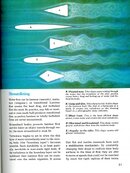The article is correct, IF there is gravity pushing two things together. Where is the force pushing the water against the diver if there is no relative motion?
Indeed, hydrodynamic drag, like aerodynamic drag, is not really all that much like friction. While, like in the case of friction, the nature of the materials in contact can have some impact in hydro/aero drag...overall object shape/size and air/water/whatever density are much larger effects usually.





